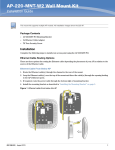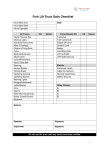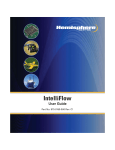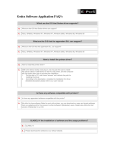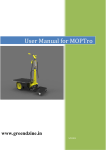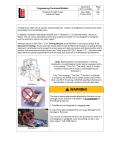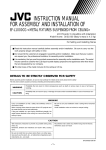Download Forklift Operations
Transcript
________________________________________________________________________ Safety and Operational Risk BP GoM Management of Forklift Operations 1 4/27/2015 Revised – Authority Change Jake Reidenbach Ken DeJohn 0 11/7/2012 Approved – Issued for GoM use Jake Reidenbach Trevor Barker Rev Date Document Status Custodian/Owner Authority Document Organization ID Control Number Sector ID Discipline ID Document Class UPS-US-SW-GOM-HSE-DOC-00105-2 Sequence Number Document Revision 1 AMENDMENT RECORD Amendment Date Revision Number Amender Initials 11/7/2012 0 JWR Updated to new OSHA standards 4/27/2015 1 JWR Updated Authority and next review date Title of Document: Authority: Custodian/Owner: Retention Code: BP GoM Management of forklift operations Ken DeJohn Jake Reidenbach ADM3000 Amendment Document Number: Revision Issue Date: Next Review Date (if applicable): Security BP Internal Page: Classification: Warning:. Check Atlas revision to ensure you are using the correct revision. UPS-US-SW-GOM-HSE-DOC00105-2 1 4/27/2015 4/27/2020 Page 2 of 16 TABLE OF CONTENTS 1 2 Introduction ................................................................................................ 4 FLT Operator Selection .............................................................................. 5 2.1.1 Potential Operators must: ............................................................... 5 3 Training....................................................................................................... 5 3.1 Training Requirements............................................................................ 5 4 Personal Protective Equipment .................................................................. 6 4.1 Personal Protective Equipment Requirements ....................................... 6 5 FLT Working Areas..................................................................................... 6 6 Design, Selection, Procurement and Maintenance of FLTs ....................... 7 6.1 Only FLTs equipped with the following design features shall be used ... 7 6.2 FLT selection considerations .................................................................. 8 6.3 Maintenance shall be in accordance with Manufacturers Operating Manual for: ........................................................................................................ 8 7 Safe Systems of Work: ............................................................................ 10 7.1 Assessments of exposure to hazardous materials shall be made for: .. 10 8 Regulatory Compliance ............................................................................ 10 8.1 FLT Recommended Practices............................................................... 10 8.1.1 DO: ................................................................................................ 10 8.1.2 DON’T: .......................................................................................... 11 Appendix “A” .................................................................................................... 12 Fork Lift Truck Routine / Pre use Checklist .................................................... 12 Daily Checks – What to Look for...................................................................... 13 Title of Document: Authority: Custodian/Owner: Retention Code: BP GoM Management of forklift operations Ken DeJohn Jake Reidenbach ADM3000 Document Number: Revision Issue Date: Next Review Date (if applicable): Security BP Internal Page: Classification: Warning:. Check Atlas revision to ensure you are using the correct revision. UPS-US-SW-GOM-HSE-DOC00105-2 1 4/27/2015 4/27/2020 Page 3 of 16 1 Introduction FORK LIFTS Industrial workplaces rely on forklift trucks (FLT’s) for their ability to lift and transport all types of equipment around industrial plants, dock terminal and other work sites. The powers of forklifts are indispensable and are considered dangerous if not operated in a safe manner. Fork lifts are operated under important safe operating and maintenance procedures to prevent unsafe incidents and hazards from occurring. The following policy supported by recommended practices, regulatory and industrial standards contains safety requirements relating to driving, use, fire protection, design, maintenance, and use of fork lift trucks, tractors, platform lift trucks, motorized hand trucks, and other specialized industrial trucks powered by electric motors or internal combustion engines. A fork lift is equipped with front-end attachments, lifting forks, rated to the designed lift capacity of the fork lift. BP employees and contractors are required to be trained and certified to work safely with and operate forklifts, and periodically there after participate in designed refresher courses. Special Notes: FLT operations can be extremely dangerous and can pose serious risks to both Operators and others in the vicinity. FLTs are potentially dangerous vehicles operated by BP because of the forward motion of weight of the unit and cargo being moved on wheels and extreme driving and operating care should be taken at all times. Industrial Standards and BP Policy The GoM RPU complies with the OSHA 29 CFR 1910.178 standards which are to be met during the procurement, operation and maintenance of forklift trucks (FLTs) and similar powered industrial trucks used on all BP onshore and offshore facilities. The standards also include requirements for the qualification and training of FLT Operators. The standards include a number of references to guidelines based on good practice in use throughout BP. The following BP policy is in place to provide safety and appropriate operating procedures in accordance to Industry Standards and company guidelines for the safety of operating personnel and equipment being transported by fork lifts.. Title of Document: Authority: Custodian/Owner: Retention Code: BP GoM Management of forklift operations Ken DeJohn Jake Reidenbach ADM3000 Document Number: Revision Issue Date: Next Review Date (if applicable): Security BP Internal Page: Classification: Warning:. Check Atlas revision to ensure you are using the correct revision. UPS-US-SW-GOM-HSE-DOC00105-2 1 4/27/2015 4/27/2020 Page 4 of 16 2 FLT Operator Selection Only selected, trained, certified and qualified persons shall be allowed to operate a FLT. 2.1.1 Potential Operators must: • Be issued a Light Vehicle Driver License by the appropriate local authority. • Have demonstrated a reliable, responsible and mature attitude to their work. • Be fit, both physically and mentally. • Be free from physical disabilities that might pose a threat to their safety and the safety of others. 3 Training 3.1 Training Requirements All BP employees and contractors shall be trained before operating a forklift. Besides formal instruction, the training must include practical training (such as demonstrations) and an evaluation of the operator in the workplace to assure he or she can operate the forklift safely. Initial training content must consist of both truck-related topics and workplace-related topics. The truck-related topics shall cover: • • • • • • • • • • • • Operating instructions, warnings and precautions specific to the trucks the employee will be authorized to operate. Differences between the truck and the automobile. Truck controls and instrumentation. Engine or motor operation. Steering and maneuvering. Visibility. Fork and attachment adaptation, operation and use limitations. Vehicle capacity. Vehicle stability. Any vehicle inspection and maintenance the operator must perform. Refueling and/or charging and recharging of batteries. Operating limitations. Workplace-related topics shall include: • • • • Surface conditions where the vehicle will be operated. Composition of loads and load stability. Load manipulation, stacking and un-stacking. Pedestrian traffic. Title of Document: Authority: Custodian/Owner: Retention Code: BP GoM Management of forklift operations Ken DeJohn Jake Reidenbach ADM3000 Document Number: Revision Issue Date: Next Review Date (if applicable): Security BP Internal Page: Classification: Warning:. Check Atlas revision to ensure you are using the correct revision. UPS-US-SW-GOM-HSE-DOC00105-2 1 4/27/2015 4/27/2020 Page 5 of 16 • • • • • Narrow aisles and other restricted places where the vehicle will be operated. Any hazardous (classified) locations, such as flammable storage areas, where the vehicle will be operated. Ramps and other sloped surfaces. Closed environments and other areas where insufficient ventilation or poor vehicle maintenance could cause a buildup of carbon monoxide or diesel exhaust, and Other unique or potentially hazardous environmental conditions in the workplace. Each driver must be re-evaluated at least once every three years to assure he or she can operate the forklift safely. Refresher training (including evaluation) must be conducted whenever a BP employee or contractor is observed operating a fork lift truck un-safely, there is an accident or near-miss, an employee fails his or her evaluation, the employee is assigned to operate a different type of truck or when there are changes in the workplace that affect safe industrial truck operation. 4 Personal Protective Equipment All operators shall be provided with the following as a minimum requirement. Additional PPE shall be considered based on risk assessments and local requirements. 4.1 Personal Protective Equipment Requirements • • • • • • Hard Hat. Safety Glasses Protective Footwear. Gloves appropriate for task. Acid proof Overalls, if appropriate. Ear Protection, if appropriate. 5 FLT Working Areas Detailed Risk Assessments shall be completed for all areas where FLTs are likely to operate. • Specific attention shall be given to raised platforms to determine where, how or why an FLT needs to operate in such an area and whether an alternative vehicle or system could be used. • Unauthorized personnel shall be prohibited from entering areas in which FLTs are operating. • Clearly demarcated lanes (e.g. broad yellow or red lines) are to be painted within all warehouses to limit areas in which FLTs may operate, as well as to restrict movement of unauthorized personnel. • FLTs shall only operate where there is safe maneuvering room, with necessary width and height clearance. Title of Document: Authority: Custodian/Owner: Retention Code: BP GoM Management of forklift operations Ken DeJohn Jake Reidenbach ADM3000 Document Number: Revision Issue Date: Next Review Date (if applicable): Security BP Internal Page: Classification: Warning:. Check Atlas revision to ensure you are using the correct revision. UPS-US-SW-GOM-HSE-DOC00105-2 1 4/27/2015 4/27/2020 Page 6 of 16 • • • • • • • • • • • • Attention shall be paid to reducing risks where FLTs are likely to encounter other traffic. Clear direction signs and the marking of doorways can help avoid unnecessary traffic movements. Working surfaces shall be level and firm. Potholes and loose material are hazardous to FLT operations. Road humps are unsuitable for FLTs. Gaps or bypasses shall be provided where necessary. Working areas and danger points (e.g. road junctions) shall be adequately and uniformly illuminated. Mirrors shall be considered where appropriate. Loading bay edges, excavations and pits shall be fitted with physical barriers or clearly marked. Operating areas shall be obstruction-free, with supports, pipe work, etc. protected by barriers. Gradients shall be as gentle as possible A FLT must never operate on a gradient exceeding the maximum specified by the manufacturer. FLTs to be parked in a secure area preferably separate from refueling or battery charging areas. Adequate ventilation to control exhaust fumes is required where internal combustion engine FLTs operate for protracted periods of time in an enclosed area. Based on the findings of the above, some areas of activity i.e. those areas, in which a FLT may not operate normally, are to be clearly demarcated by means of solid distinctive lines painted onto the road surface and appropriate notices. 6 Design, Selection, Procurement and Maintenance of FLTs All FLTs shall be procured through the BP procurement specialists who will remain responsible for ensuring that all S&OR safety requirements are met. 6.1 Only FLTs equipped with the following design features shall be used • • • • • • • Automatic audible warning devices that activate when the FLT moves backwards. Similar devices for forward movement can be considered. An orange flashing beacon light that is activated when the ignition switch is moved into the On Position. Operating lights in full working condition at all times. Rear view mirror(s). Hour meters for measuring operating hours and service intervals. An approved two-point seatbelt with appropriate roll over protection cage. Appropriate decals to be pasted on dashboard/rollover cage covering rollover position by Operator as prescribed by the manufacturer. Title of Document: Authority: Custodian/Owner: Retention Code: BP GoM Management of forklift operations Ken DeJohn Jake Reidenbach ADM3000 Document Number: Revision Issue Date: Next Review Date (if applicable): Security BP Internal Page: Classification: Warning:. Check Atlas revision to ensure you are using the correct revision. UPS-US-SW-GOM-HSE-DOC00105-2 1 4/27/2015 4/27/2020 Page 7 of 16 • Decal stating “Authorized Operators Only”. 6.2 FLT selection considerations • • • • • Stability (weight of materials to be handled, outreach required, nature of terrain, etc.) The guarding of dangerous parts. Noise generated by the FLT. Operator comfort, protection from the weather and falling objects. Air suspension seating or other suitable sprung seating to protect Operator from back or similar injury. Padded or foam rubber seats shall not be permitted. 6.3 Maintenance shall be in accordance with Manufacturers Operating Manual for: • • Daily checks. ( review daily maintenance check list prior to operation) Prescribed service intervals. Maintenance routines shall cover the condition of brakes, lights, horns, hydraulic systems and tires, and the integrity of the structure and moving parts and any other components the manufacture recommends for daily checks. Appropriate, fit-for-purpose pre-use check sheets are to be used and signed off by Operators, Supervisors and Maintenance Personnel as applicable. See Appendix “A” for an example. Pre-use checklist shall be completed prior to daily start-up by the operator. Forks in use (single shift operation) shall be inspected at intervals of not more than 12 months or whenever any defect or permanent deformation is detected. Severe applications require more frequent inspection at an interval set by the GoM Lifting Technical Authority. Fork inspection shall be carried out carefully by trained personnel with the aim of detecting any damage, failure, deformation, or other condition that might impair safe use. A fork that shows any of the following defects shall be withdrawn from service, and shall not be returned to service until it is satisfactorily repaired by the fork manufacturer or an expert of equal competence: • The forks shall undergo a thorough visual examination and MPI on an annual basis which will look for cracks with special attention to the 90 degree heel. Inspection for cracks shall include any mounting mechanisms of the fork blank to the fork carrier. Forks shall not be returned to service if surface cracks are detected. • Straightness of the upper face of the blade and the front face of the shank shall be checked annually. If deviation from straightness exceeds 0.5% of the length of the blade and/or the height of the shank, respectively, the Title of Document: Authority: Custodian/Owner: Retention Code: BP GoM Management of forklift operations Ken DeJohn Jake Reidenbach ADM3000 Document Number: Revision Issue Date: Next Review Date (if applicable): Security BP Internal Page: Classification: Warning:. Check Atlas revision to ensure you are using the correct revision. UPS-US-SW-GOM-HSE-DOC00105-2 1 4/27/2015 4/27/2020 Page 8 of 16 • fork shall not be returned to service until it has been repaired by the OME or qualified OME Representative. Fork Angle (Upper Face of Blade to Load Face of the Shank) shall be checked on an annual basis, any fork with a deviation greater than 3 % from the original specification shall not be returned to service. The rejected fork shall be reset and tested in accordance with manufacturer’s recommendations. • If the difference in height of one set of forks when mounted on the fork carrier exceeds 3 % of the length of the blade, the set of forks shall not be returned to service until repaired. It shall be confirmed that the positioning lock is in good repair and in correct working order. If any fault is found, the fork shall be withdrawn from service until satisfactory repairs are made. • The fork blade and shank shall be thoroughly checked for wear on an annual basis, with special attention to the vicinity of the heel. If thickness is reduced to 90 % of the original thickness, the fork shall not be returned to service. When fork markings are not clearly legible, it shall be renewed. Marking shall be renewed per instructions from the original fork supplier. • Fork Repair Only the manufacturer of the fork or an expert of equal competence approved by the manufacture shall decide if a fork may be repaired for continued use, and the repairs shall only be carried out by such authorities. Surface cracks or wear shall not be repaired by welding. When resetting repairs are required, the fork shall be subject to heat treatment. Fork Load Test A fork that has undergone repair, other than repair or replacement of positioning locks or marking, shall be subject to a load test as described in ASME B56.1, Section 7.25, "Forks," Item 3, which lists loading and method of test for forks; except for the test load, which shall correspond to 2.5 times the rated capacity marked on the fork. Forklift Load Test Forklift truck load tests are not routinely required. Load tests shall be performed after major repair or modification to components that affect the load-carrying ability of the truck. The manufacturer should be consulted if questions arise as to whether a load test is appropriate. Forklift trucks shall be load tested by or under Title of Document: Authority: Custodian/Owner: Retention Code: BP GoM Management of forklift operations Ken DeJohn Jake Reidenbach ADM3000 Document Number: Revision Issue Date: Next Review Date (if applicable): Security BP Internal Page: Classification: Warning:. Check Atlas revision to ensure you are using the correct revision. UPS-US-SW-GOM-HSE-DOC00105-2 1 4/27/2015 4/27/2020 Page 9 of 16 the direction of the manufacturer of the forklift or an expert of equal competence approved by the manufacture. 7 Safe Systems of Work: Regular FLT routes shall be checked periodically for obstacles and obstructions. Where possible, tape off area and or mark with posts the loading and or off loading area to alert persons coming close by the working area. 7.1 • • • • • • • • • Assessments of exposure to hazardous materials shall be made for: Any hazardous substance carried by a FLT. Exhaust fumes from FLTs powered by an internal combustion engines. Where possible the utilization of portable CO2 monitors should be used when FLTs are operating in a closed environment. The handling of fuels and battery acids. Good basic safety practice shall be observed when refueling FLTs or recharging batteries. Electrical systems shall be protected and hot surfaces shall be eliminated. Only diesel engine FLTs are to be used in areas where there is a risk of a flammable atmosphere. Spark arrestors shall be fitted to diesel engine exhausts, and measures taken to prevent the intake of flammable vapors. Individuals shall not be raised on the FLT’s forks at any time. Where individuals need to be raised, an approved safety cage shall be used. Storage racks shall be securely fastened to prevent them being dislodged in the event of a handling error. Passengers shall not be carried at any time unless the manufacturer has provided for a passenger and BP management has granted written authorization. 8 Regulatory Compliance All FLT operations and maintenance shall be in compliance with all national and local regulations and requirements which include, US OSHA compliance program, BP policy, ANSI B56.1-2004. 8.1 FLT Recommended Practices 8.1.1 DO: • Park with the forks lowered, with the parking brake on and the engine switched off. Title of Document: Authority: Custodian/Owner: Retention Code: BP GoM Management of forklift operations Ken DeJohn Jake Reidenbach ADM3000 Document Number: Revision Issue Date: Next Review Date (if applicable): Security BP Internal Page: Classification: Warning:. Check Atlas revision to ensure you are using the correct revision. UPS-US-SW-GOM-HSE-DOC00105-2 1 4/27/2015 4/27/2020 Page 10 of 16 • • • • • • • • • • Wear a seat belt and appropriate PPE at all times. Remain in the zone demarcated for FLTs. Avoid pedestrians. Sound horn at danger spots. Avoid sudden braking and changes of direction. Travel with forks (1 to 2 feet above the ground and with the mast tilted back Look in the direction of travel. Travel up and downhill with the forks pointing downhill, when unloaded. Travel up and downhill with the forks pointing uphill, when loaded. Ensure adequate overhead clearance before lifting. 8.1.2 DON’T: • • • • • • • • • • Drink and drive. Drive if affected by drugs, legal or illegal. Turn across an incline in either direction. Speed, especially when going downhill. Pick up a load if someone is close to it. Allow people to walk under a load. Carry loads that block forward or in a reverse motion, where visibility is impaired a signal man / flagman shall be present as a guide. Move a load that appears to be unstable. Carry passengers. Drive over cables or flexible pipes. Title of Document: Authority: Custodian/Owner: Retention Code: BP GoM Management of forklift operations Ken DeJohn Jake Reidenbach ADM3000 Document Number: Revision Issue Date: Next Review Date (if applicable): Security BP Internal Page: Classification: Warning:. Check Atlas revision to ensure you are using the correct revision. UPS-US-SW-GOM-HSE-DOC00105-2 1 4/27/2015 4/27/2020 Page 11 of 16 Appendix “A” Fork Lift Truck Routine / Pre use Checklist Date: Serial Number Hour Meter Start Model All Trucks OK Defect Fluids/Belts/Batteries Faults Previous Day Fuel Level Obvious Leaks Fuel Connectors Hydraulic Fluid Levels Engine Oil Level Mast & Carriage Coolant Level Chains & Fixing Bolts Battery Forks Backrest/Extension Fan/Other Belts LPG Bottle Security OK Defect Attachments Tires/Wheels/Nuts Seat & Seat Belt Steering Electric Service Brakes Electrolyte Levels Parking Brake Cable Connections Operating Controls General Cleanliness Operating System Battery Security Warning Lights Gauges/Instruments Lights/Beacon Specific Manufactures Checks Horn A. Alarms B. Other Warning Devices C. Safety Guards/Covers D. Bodywork Defects: Operator Signature Supervisor Signature Title of Document: Authority: Custodian/Owner: Retention Code: BP GoM Management of forklift operations Ken DeJohn Jake Reidenbach ADM3000 Document Number: Revision Issue Date: Next Review Date (if applicable): Security BP Internal Page: Classification: Warning:. Check Atlas revision to ensure you are using the correct revision. UPS-US-SW-GOM-HSE-DOC00105-2 1 4/27/2015 4/27/2020 Page 12 of 16 Daily Checks – What to Look for All Trucks Faults Previous Day - Check the previous page (or book). This will identify what may have been wrong the previous day or shift. You should check these items carefully to ensure that the fault has been rectified. Obvious Leaks - Check the floor, beside and under the truck. Hydraulic Fluid Level - Check the level in the reservoir. Mast and Carriage - Visually check for any damage or foreign items. Check also for appropriate lubrication. Chains and Fixing Bolts - Visually check for damaged links, obvious stretching and appropriate lubrication. Visually check the fixing bolts for any sign of damage. Forks - Visually check for any sign of cracks, especially at the heels, or any other sign of damage or excess wear. Check securing pins. Backrest/Extension - Visually check for damage or debris. Bent or otherwise damaged metal is weakened and may be dangerous. Attachments - Check for the actual security of the attachment, at its fixing or locking points, and check any hydraulic or other connections. Some attachments may need additional checks. Only check and use attachments if you have been trained to do so. Tires/Wheels/Nuts - Check all tires for obvious damage, including cuts and tread wear. Check pneumatic tires for the correct pressure. Check wheels for damage, especially to the rims, and check that wheel nuts are tight. Seat and Seat Belt - Check that the seat is correctly fixed to the truck and not loose or damaged. Check that the seat belt or other restraint is properly secure and functions correctly. Steering - Check that the steering feels normal and there is no undue play or unusual movement. Service Brakes - Check that the brakes feel normal and work efficiently. Parking Brake - Check the parking brake works efficiently and releases correctly. Title of Document: Authority: Custodian/Owner: Retention Code: BP GoM Management of forklift operations Ken DeJohn Jake Reidenbach ADM3000 Document Number: Revision Issue Date: Next Review Date (if applicable): Security BP Internal Page: Classification: Warning:. Check Atlas revision to ensure you are using the correct revision. UPS-US-SW-GOM-HSE-DOC00105-2 1 4/27/2015 4/27/2020 Page 13 of 16 Operating Controls - Check that all foot and hand controls operate correctly and are not obstructed in any way. Operating System - If the truck is fitted with computerized systems check to ensure that they have initialized and are working correctly. Warning Lights - Check for the correct operation of all warning lights. If a light stays on, and you are not sure of its meaning, check the user manual or seek further advice. Do not use the truck with a warning light illuminated if you do not know it is still safe! Gauges/Instruments - Check that all gauges and other instruments are working correctly. Lights/Beacon - Check for correct operation. Horn - Check for correct operation. Alarms - Check for correct operation. Other Warning Devices - Make sure you know what is fitted to the truck. Check all for correct operation. Safety Guards and Covers - Check all are properly fastened and secured. A flapping cover can be a hazard to your colleagues as well as yourself. Bodywork - Visually check around the vehicle. Damaged bodywork may indicate other problem areas on the truck. Check the areas carefully. Damaged bodywork may indicate damage to racking or other equipment. Report what you find so that your supervisor can check it out. Fluids/Belts/Batteries Fuel Level - Check the level and refuel as needed. Remember to wear protective gloves and keep away from cigarettes or other fire hazards. Engine Oil Level - Check and top up as needed. Coolant Level - Check and top up as needed. Battery - Ensure the battery is secure and clean. Check the level of distilled water and top up as needed. Wear eye protection and gloves. Fan/Other Belts - Check for correct tension and obvious damage. LPG Bottle Security - Check the bottle is secure and clamps are fully tightened. Ensure connections are secure. Title of Document: Authority: Custodian/Owner: Retention Code: BP GoM Management of forklift operations Ken DeJohn Jake Reidenbach ADM3000 Document Number: Revision Issue Date: Next Review Date (if applicable): Security BP Internal Page: Classification: Warning:. Check Atlas revision to ensure you are using the correct revision. UPS-US-SW-GOM-HSE-DOC00105-2 1 4/27/2015 4/27/2020 Page 14 of 16 Electric Electrolyte Levels - Check the electrolyte levels of all cells. Cable Connections - Check they are clean and properly secure. General Cleanliness - Ensure the battery area is clean and clear from debris. Battery Security - Ensure the batteries are secure within their compartment and that any protective hatches are properly closed. Other Checks Other items may need to be checked. Refer to manufacture inspection & maintenance guidelines. These may be listed on a separate sheet. Discuss this with your supervisor. Remember, if you are unsure sure about anything at all, ask your supervisor. Title of Document: Authority: Custodian/Owner: Retention Code: BP GoM Management of forklift operations Ken DeJohn Jake Reidenbach ADM3000 Document Number: Revision Issue Date: Next Review Date (if applicable): Security BP Internal Page: Classification: Warning:. Check Atlas revision to ensure you are using the correct revision. UPS-US-SW-GOM-HSE-DOC00105-2 1 4/27/2015 4/27/2020 Page 15 of 16 Title of Document: Authority: Custodian/Owner: Retention Code: BP GoM Management of forklift operations Ken DeJohn Jake Reidenbach ADM3000 Document Number: Revision Issue Date: Next Review Date (if applicable): Security BP Internal Page: Classification: Warning:. Check Atlas revision to ensure you are using the correct revision. UPS-US-SW-GOM-HSE-DOC00105-2 1 4/27/2015 4/27/2020 Page 16 of 16
















